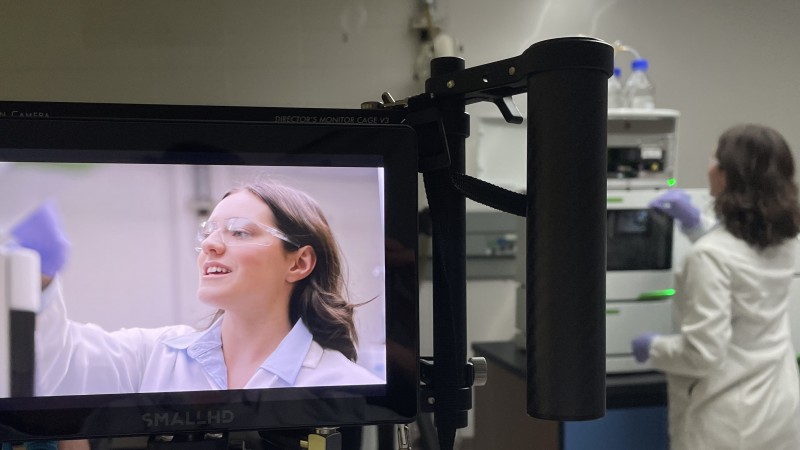
Making Scientific Labs Visually Come to Life
Take a look at the image on the left, the one on the client monitor. Looks beautiful, right? That isn’t something that just happens when you go shoot in a lab space. Of course, important scientific work is going on there, but in order for it to really shine on your scientific marking video, you need to take steps.
1. Use lighting (if possible).
Lighting is one of the most critical elements when it comes to filming in a lab. The first thing to consider is the color temperature of the light. A cool white color temperature of around 5000-6500K is typically best for lab footage as it provides a clean look. However, be careful not to use lighting that is too bright or harsh, as this can cause reflections on shiny surfaces or even damage sensitive equipment.
When it comes to placement, you want to highlight the essential elements of the lab while avoiding creating any shadows. Three-point lighting is an excellent technique for illuminating a space while minimizing shadows. However, keep in mind that expensive lab equipment may be sensitive to certain lighting conditions, so try to be respectful to the work being done in the lab.
2.Clean up
Cleaning up a lab space can be a daunting task, but it's essential to make sure the space looks as professional and presentable as possible. Start by removing any clutter from the shot, including extraneous equipment or consumables. Try to keep only the essential elements necessary for the scene. Additionally, wipe down any surfaces that will be in the shot to remove any dust or debris.
One thing to keep in mind is that many lab surfaces are reflective and can pick up unwanted glare or reflections. Using a polarizing filter on your camera lens can help reduce glare and make the footage look more polished.
Take some time before the shoot to clean up the space as much as possible. While some items may not be movable, tidying up the lab will make it look better on camera and make your video pop.
3.Cast and props
The right cast and props are crucial to creating a successful video. If you're showcasing a scientific process, it's important to have someone knowledgeable about the process in front of the camera. This could be a lab technician or even a scientist. They should be comfortable on camera and able to speak fluently about the process.
If you're creating a more general marketing video, you may want to consider using an actor. Make sure to choose someone who fits the part and can convincingly portray the role you're trying to showcase. Props can also be helpful in demonstrating the process you're showcasing. For example, if you're demonstrating a PCR reaction, having a clear model of the reaction can help the viewer understand the process better.
In short, filming in a lab requires careful consideration of lighting, cleanliness, and casting. By following these tips and techniques, you can create high-quality footage that effectively showcases your scientific work. Good luck with your video!
Posted: 04/18/2023
